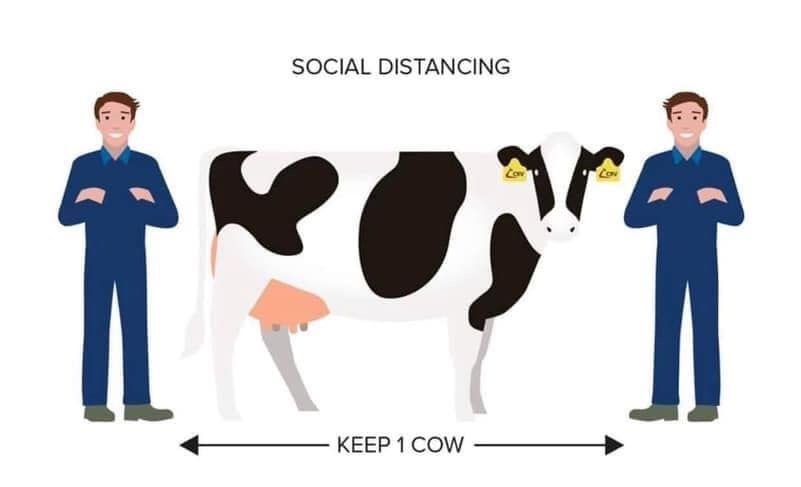
Paul D. Mitchell, Agricultural and Applied Economics, UW-Madison
April 3, 2020
Office: (608) 265-6514 | Email: pdmitchell@wisc.edu | Web: http://www.aae.wisc.edu/pdmitchell
To read and download this blog as a PDF CLICK HERE
Governor Ever’s Safer-at-Home declaration includes agriculture as an essential business, meaning that as many of us shelter at home, farmers and agribusiness workers are expected to continue doing their jobs during this pandemic despite the risks. OSHA’s Guidance for Preparing Workplace for COVID-19 technically classifies this sort of work as “Lower Exposure Risk” (p. 20) and has several recommendations consistent with “social distancing” (p. 8-10). This document here explains social distancing for farmers and how to incorporate it into their farm operations with three main points. First, keeping your distance from people you interact with for work. Second, more cleaning and disinfecting frequently touched surfaces. Third, creating a system for service providers coming on to your farm and when you visit business.
What is Social Distancing?
In brief, social distancing is common sense behavior (WI DHS: COVID-19: Avoid Illness):
- Stay 6 feet from others
- Wash your hands frequently
- Avoid touching your face/eyes/mouth
- Cover your coughs and sneezes
- If you feel sick, stay home
This virus seems to spread through droplets produced by an infected person’s coughs and sneezes, and it’s thought that we can pick it up if those droplets land directly on us or if we touch a surface that has been contaminated by those droplets. Because of the way it spreads, we need to stay far enough apart so we don’t spread it to each other and frequently wash our hands and commonly touched surfaces with soap or alcohol-based cleaning agents.
People spread this virus as droplets through coughs and sneezing, so we need to stay far enough apart so we don’t spread it to each other (CDC: How COVID-19 Spreads). It seems that many people do not show symptoms, at least for a few days, yet can spread the virus causing COVID-19. This means you or people you are working with may feel fine, but be spreading the virus. That’s why it’s important to stay physically separated, even if everyone feels fine. The hard part is that we are naturally social – we want to spend time together and interact, but we need to adjust our natural behavior for a while, until the pandemic is under control.
DATCP’s Basic Biosecuity page lists practices for farms that generally apply to this coronavirus. Again, they are common sense, but it is a good time to review them again. A simple way to think of it is as though you have been working with manure or spraying pesticides – wash your hands and face well before interacting with your family and eating. The same thing with your clothes – assume they are contaminated. Wear coveralls and change out of your work clothes before interacting with your family and have a separate designated place to place your work clothes, those to be worn again and those to be washed.
The DATCP Basic Biosecurity page also explains how to clean and disinfect frequently touched surfaces and equipment. The CDC’s Cleaning and Disinfection for Households also has some useful guidelines for households that farm families can use at home, but they also apply to work areas like bathrooms and break rooms that some farms have.
Dealing with Deliveries and Visitors
Farms are places of business, often with regular visitors making pick-ups or deliveries, plus farmers often need to pick up or deliver things to other businesses. Extension county agriculture agents have developed a practical guide for farmers to create a system for service providers, including a template to use (Managing Visitors and Deliveries to Farms). Also see I’m Having Products Delivered to my Farm – What Precautions Should I Take? Based on guidelines the NCGA developed for farmers.
Besides practicing social distancing with service providers, the idea is to develop a protocol to minimize unneeded interactions between service providers and your employees and family members. If possible, communicate with them before they arrive on what you want them to do. Clearly post a phone number of who to contact if they have questions once they arrive and clearly indicate areas that are off limits to visitors, such as breakrooms or bathrooms. The document also has practical advice for how to deal with the regular business correspondence that is part of running a farm – thoughts on how to communicate without physically interacting.
The same concept applies for when a farmer visits a place of business – again social distancing is important. Know what you need and where you are going at the business and try to minimize your interactions with their employees by using a little planning and other means of communicating such as cell phones or texts. This may be a simple as calling the business from the parking lot to find out where to go and what to do, someone loading your vehicle while you sit inside, and then paying for it online, possibly right from the parking lot on your phone.
Remember that this social distancing is temporary; eventually, we can get back to more normal interactions. Unfortunately, for the near term, this is our new reality until this pandemic passes.


